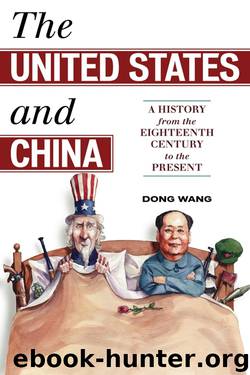The United States and China by Dong Wang

Author:Dong Wang [Wang, Dong]
Language: eng
Format: epub
Tags: undefined
Publisher: Rowman & Littlefield Publishers
Published: 2012-09-21T16:00:00+00:00
Deterrence and Negotiation: American-Chinese Relations during the Cold War
This chapter sheds new light on the deep conflicts as well as the positive dynamics in Sino-American relations in the 1950s and 1960s. Some scholars refer to these years as the “great interregnum” because formal diplomatic relations were not reestablished until 1979. American support for the Guomindang (GMD) in the Chinese civil war and its military involvement in the Korean War, combined with Chinese advocacy of Third World revolutions, fed political and ideological conflict. At the same time—behind the scenes—both nations were feeling their way toward some kind of equilibrium. Key issues during this period include U.S. recognition of the People’s Republic of China (PRC), China’s representation in the United Nations, the Korean and Vietnam wars, and continuing geopolitical maneuverings—spanning the spectrum from hostility to negotiation—between the two countries.
Three points are worth noting. First, while American-Chinese relations were publicly contentious, following the armistice in the U.S.-Korean War, the leaders of both nations sought ways of easing the tensions between them behind closed doors. No fewer than 136 bilateral ambassadorial exchanges punctuated the decade and a half between August 1955 and February 1970. In 1973 the PRC and the United States established liaison offices in each other’s capitals.[1] Despite the overt atmosphere of hostility, the two nations maintained channels of communication at various levels—official and unofficial, direct and indirect.[2]
Second, the Taiwan issue—the “One China” or the “Two Chinas” question[3]—was a stumbling block to good relations, resulting from America’s long-standing commitment to Taiwan (formerly known as Formosa) and, opposing this stance, mainland China’s consistent claim that the island territory was integral to its sovereignty as accorded by the Cairo Declaration of 1943.[4] Arising from international and domestic developments in the 1950s, the Taiwan question posed a formidable obstacle to the normalization and improvement of relations between the United States and China. In negotiations of the 1950s, the United States sought repudiation of force in the Taiwan Strait by both mainland China and Taiwan, while China insisted on negotiating directly with Chiang Kai-shek and approached Taiwan as an issue of sovereign rights, an internal rather than an international matter.
The third proposition is that the road leading to the rapprochement achieved in 1971 was a slow but ongoing process which transformed both sides. A wide variety of views on whether the United States should recognize the PRC had been expressed within government policy-making circles, as well as by intellectuals, businessmen, and ordinary Americans.[5] The Chinese by contrast showed a firmer consensus, adhering to their One China policy while asserting that the “Chinese people did not want to pick a fight with the United States and the Chinese government was willing to sit down and negotiate with the American government.”[6] In the 1950s and 1960s, American pluralism and the Chinese capacity to make policy adjustments gradually created the foundations for the final diplomatic breakthrough. Thus the rapprochement that occurred during the Nixon presidency (1969–74)—driven as it was by a rebalancing of global geopolitics—did not happen just overnight.
Download
This site does not store any files on its server. We only index and link to content provided by other sites. Please contact the content providers to delete copyright contents if any and email us, we'll remove relevant links or contents immediately.
| Anthropology | Archaeology |
| Philosophy | Politics & Government |
| Social Sciences | Sociology |
| Women's Studies |
The Secret History by Donna Tartt(18786)
The Social Justice Warrior Handbook by Lisa De Pasquale(12098)
Thirteen Reasons Why by Jay Asher(8759)
This Is How You Lose Her by Junot Diaz(6721)
Weapons of Math Destruction by Cathy O'Neil(6100)
Zero to One by Peter Thiel(5650)
Beartown by Fredrik Backman(5565)
The Myth of the Strong Leader by Archie Brown(5390)
The Fire Next Time by James Baldwin(5215)
How Democracies Die by Steven Levitsky & Daniel Ziblatt(5105)
Promise Me, Dad by Joe Biden(5048)
Stone's Rules by Roger Stone(5000)
100 Deadly Skills by Clint Emerson(4815)
A Higher Loyalty: Truth, Lies, and Leadership by James Comey(4813)
Rise and Kill First by Ronen Bergman(4669)
Secrecy World by Jake Bernstein(4608)
The David Icke Guide to the Global Conspiracy (and how to end it) by David Icke(4571)
The Farm by Tom Rob Smith(4412)
The Doomsday Machine by Daniel Ellsberg(4386)
